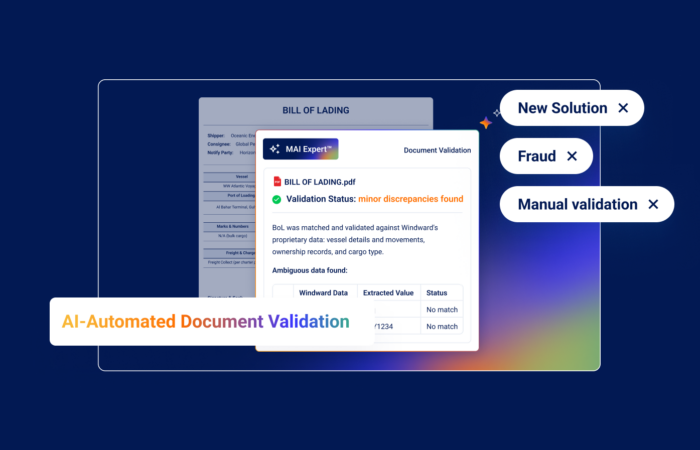3 tips for identifying dark activity

What’s inside?
As we’ve seen in part 1 of this series, performing Vessel Due Diligence by screening AIS transmission gaps can protect companies from inadvertently doing business with bad actors. It’s also now increasingly required by regulators. Meanwhile, analysts are struggling with false positives and a labor-intensive, manual screening process to distinguish between ‘lost’ signals and true ‘dark’ activity.
Filtering through the noise
Fortunately, as previously discussed, by differentiating between lost signals and true dark activity we can reduce the number of flagged events considerably. By how much you ask?
In March of 2019, 529 crude oil tankers visited the Gulf. Of those, 352 tankers (two-thirds of the total) had gaps in their AIS transmissions for more than eight hours – gaps which are defined by OFAC as a red flag for sanctions evasion. Focusing just on dark activity reduced the list to 29 vessels: a mere 5%.

Screening AIS transmission gaps for dark activity
Now that we’ve seen the vast majority of instances are innocent, how do we go about efficiently finding the real red flags? There are many potential tells but here we are going to focus on three. Let’s go started:

1. Quality of AIS coverage
The very first step is to assess the quality of AIS coverage at a particular point in time and space. As mentioned in part one of the series, AIS signals are often lost due to insufficient receiving stations or signal collision. But if no other vessels in the vicinity had an issue with their transmissions it seems unlikely another one would. Since AIS coverage is usually best near ports and shores, lost events that are less than 30NM from shore are more likely to be dark. What’s more, even if a suspicious transmission gap occurred in the past, and data about the vessels surrounding it at that time are not available, analyzing the transmissions of vessels in that area in the present can still provide valuable insight into quality of coverage.
2. Time unaccounted for
Next, measure how much time cannot be accounted for. This is a bit more complicated but the basic idea is to establish the distance between the point at which the AIS signal was lost and the point at which it was found. You then use the vessel’s known sailing speed (either regular sailing speed, speed before/after lost, or average of the two) to calculate how long it should have taken the ship to travel between the two points. If the two fail to match, then the question you need to ask is simple: what was it up to during that time?
PRO TIP: don’t draw a straight line to calculate distance travelled; you need to account for sailing lanes and patterns in a region to assess the true distance.

3. Feasibility of dark trade
What if there was good coverage in the area and you find a chunk of time unaccounted for? Well, then you move to the final step which is to assess the feasibility of dark trade. If you see a significant amount of time unaccounted for, the vessel may have been able to call at a port or meet with another ship for transshipment. But to load or discharge cargo takes time – as much as several days.

Lost or Dark?

Further investigation of dark activity
The three steps above are sufficient grounds to assume this lost signal is actual dark activity and escalate the case for further investigation. Remember dark activity can conceal illicit trade but cannot, in and of itself, prove any illicit activity occurred. To establish more conclusive evidence we need to take a deeper look at four factors:
- Geographical context: is the dark activity near a known transhipment area or sanctioned port? Going dark in the eastern Mediterranean, Gulf or off the coast of Venezuela is certainly different than doing so in the North Sea.
- Historical sailing activity: has this vessel traded with a sanctioned country in the past? If they used to visit there before sanctions were introduced then it’s more likely they might still be trading there covertly after sanctions kicked in.
- Established patterns of illicit behavior: Is the vessel following a similar pattern to known cases of sanctions evasion, smuggling or trafficking? This is the most damning evidence since there is usually no economic justification for the anomalous operations employed by bad actors.
- Context of the trade: if a vessel discharged at port, then was lost, and then discharged again, it’s a strong signal that somewhere during the time it wasn’t transmitting it loaded cargo with origins unknown. Or if a vessel is sailing all the way to a certain area, disappears and then resumes transmissions while heading elsewhere, it indicates it had a financial motivation to sail towards a certain area to begin with – possibly to load or discharge.

Great. Now we know how to find dark activity and assess it for the risk of illicit activity. But you might be asking yourself at this point: how can I possibly do this for every vessel I screen without slowing down business or hiring a whole team of analysts? In the next instalment of this blog series, we’ll discuss how AI (artificial intelligence) can supercharge your AIS screening.












